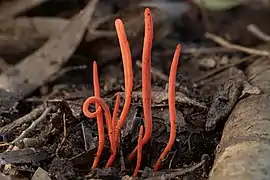Clavulinopsis sulcata
Clavulinopsis sulcata is a clavarioid fungus in the family Clavariaceae and is the type species of the genus Clavulinopsis. It forms very long, slender, cylindrical pinkish or orange fruiting bodies that grow on the ground among plant litter.
| Clavulinopsis sulcata | |
|---|---|
 | |
| Scientific classification | |
| Domain: | Eukaryota |
| Kingdom: | Fungi |
| Division: | Basidiomycota |
| Class: | Agaricomycetes |
| Order: | Agaricales |
| Family: | Clavariaceae |
| Genus: | Clavulinopsis |
| Species: | C. sulcata |
| Binomial name | |
| Clavulinopsis sulcata Overeem (1923) | |
| Synonyms[1] | |
| |
Taxonomy
The fungus was originally described by the English cryptogamist Miles Joseph Berkeley in 1843 as Clavaria miniata, from collections made in Uitenhage, South Africa.[3] Dutch mycologist Casper van Overeem gave it the name by which it is now known in 1923, when he made it the type species of the newly circumscribed genus Clavulinopsis.[4] It forms part of a species complex.[2]
Description
The fruit body of Clavulinopsis sulcata is cylindrical or somewhat club-shaped, up to 70 by 7 mm (2.8 by 0.3 in) borne on a cylindrical stipe up to 20 mm (0.8 in) long. Several fruit bodies may grow close together, or they may grow singly, or in groups of two or three. At first they are tapering, but become irregularly fleshy or inflated later, and ridged or wrinkled and somewhat waxy as they age. The flesh is pink or orange-pink; the stipe is a similar colour but is pale pinkish-salmon at the base. The flesh is odourless and tastes mildly of carrots, with a slightly bitter aftertaste. The spores are borne on the sides of the clubs and have thin walls; they measure 5.8–7.2 by 5.8–6.8 µm, and are globose and opalescent.[5]
Distribution and habitat
Clavulinopsis sulcata has a widespread distribution. It was first described (as Clavaria miniata) from South Africa, and is also present in North America,[6] and Asia. In Australasia, it is found in eastern Australia and New Zealand, where its range includes the states of Queensland, New South Wales, Victoria and Tasmania, as well as both islands of New Zealand. It is a fairly common fungus, and its conservation status has been assessed as being of least concern. It grows on the ground among leaf litter.[7] In Tasmania it is found in mixed Nothofagus and Leptospermum woodland.[8]
References
- "GSD Species Synonymy: Clavulinopsis sulcata Overeem". Species Fungorum. CAB International. Retrieved 2015-05-22.
- Petersen RH. (1978). "Notes on clavarioid fungi. XV. Reorganization of Clavaria, Clavulinopsis and Ramariopsis". Mycologia. 70 (3): 660–71. doi:10.2307/3759402. JSTOR 3759402.
- Berkeley MJ. (1843). "Enumeration of fungi, collected by Herr Zeyher in Uitenhage". London Journal of Botany. 2: 507–27 (see p. 516).
- van Overeem C. (1923). "Beiträge zur Pilzflora von Niederländisch Indien". Bulletin du Jardin botanique de Buitenzorg (in German). 3 (3): 247–96.
- Petersen, R.H. "Clavaria sulcata". New Zealand's Virtual Mycota. Landmark Research. Retrieved 19 March 2021.
- "Clavulinopsis sulcata". NatureServe Explorer. Retrieved 20 March 2021.
- "Clavulinopsis sulcata Overeem". Atlas of Living Australia. Retrieved 19 March 2021.
- Birkebak, J.M. (1 December 2015). "Systematics and diversification patterns of morphologically and ecologically diverse lineages of Agaricomycetes: Clavariaceae and Cantharellales". University of Tennessee. Retrieved 20 March 2021.